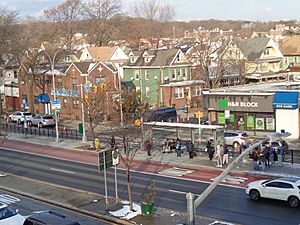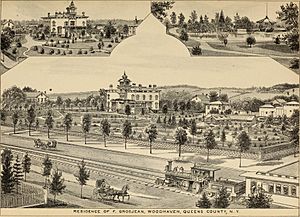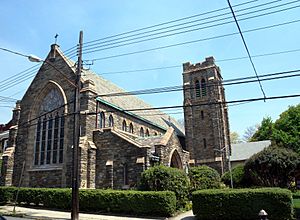Woodhaven, Queens facts for kids
Quick facts for kids
Woodhaven
|
|
|---|---|
|
Neighborhood of Queens
|
|

View from the Woodhaven Boulevard subway station
|
|
| Country | |
| State | |
| City | |
| County/Borough | |
| Community District | Queens 9 |
| Population | |
| • Total | 56,674 |
| Ethnicity | |
| • Hispanic | 53.5% |
| • Asian | 17.4% |
| • White | 17.3% |
| • Black | 6.1% |
| • Other | 5.7% |
| Economics | |
| • Median income | $51,596 |
| Time zone | UTC−5 (EST) |
| • Summer (DST) | UTC−4 (EDT) |
| ZIP Code |
11421
|
| Area codes | 718, 347, 929, and 917 |
Woodhaven is a neighborhood in the southwestern section of the New York City borough of Queens. It is bordered on the north by Park Lane South and Forest Park, on the east by Richmond Hill, on the south by Ozone Park and Atlantic Avenue, and on the west by the Cypress Hills neighborhood of Brooklyn.
Woodhaven, once known as Woodville, has one of the greatest tree populations in the borough and is known for its proximity to the hiking trails of Forest Park. Woodhaven contains a mixture of urban and suburban land uses, with both low-density residential and commercial sections. It retains the small-town feel of bygone days and is home to people of many different ethnicities.
Woodhaven is located in Queens Community District 9 and its ZIP Code is 11421. It is patrolled by the New York City Police Department's 102nd Precinct. Politically, Woodhaven is represented by the New York City Council's 28th, 30th, and 32nd Districts.
Contents
Boundaries
Woodhaven is bordered on the north by the public Forest Park, and Park Lane South. Woodhaven also borders Richmond Hill to the east, and Ozone Park to the south at Atlantic Avenue. Its western border is the borough of Brooklyn.
The ethnically diverse neighborhood is part of Queens Community Board 9. Woodhaven's ZIP Code is 11421. Woodhaven is served by New York City Department of Education School District #27 (Bounded by Nassau County on one side and Brooklyn on the other).
Geology
The Wisconsin Glacier retreated from Long Island some 20,000 years ago, leaving behind the hills to the north of Woodhaven that now are part of Forest Park, the third largest park in Queens. Southern Woodhaven is mostly flat (the lowest elevation is just under 30 feet (9.1 m) ), while northern Woodhaven gradually rises to about 105 feet (32 m) as it approaches Forest Park.
History
European settlement in Woodhaven began in the mid-18th century as a small town that revolved around farming, with the Ditmar, Lott, Wyckoff, Suydam and Snediker families. British troops successfully flanked General George Washington's Continental Army by a silent night-march from Gravesend, Brooklyn through the lightly defended "Jamaica Pass" actually located in Brooklyn, to win the Battle of Long Island, Queens—the largest battle of the American Revolutionary War, and the first battle after the Declaration of Independence.
Later, Woodhaven became the site of two racetracks: the Union Course (1821) and the Centerville (1825). Union Course was a nationally famous racetrack situated in the area now bounded by 78th Street, 82nd Street, Jamaica Avenue and Atlantic Avenue. The Union Course was the site of the first skinned—or dirt—racing surface, a curious novelty at the time. These courses were originally without grandstands. The custom of conducting a single, four-mile (6 km) race consisting of as many heats as were necessary to determine a winner, gave way to programs consisting of several races. Match races between horses from the South against those from the North drew crowds as high as 70,000. Several hotels (including the Snedeker Hotel and the Forschback Inn) were built in the area to accommodate the racing crowds.
A Connecticut Yankee, John R. Pitkin, developed the eastern area as a workers' village and named it Woodville (1835). In 1853, he launched a newspaper. That same year, the residents petitioned for a local post office. To avoid confusion with a Woodville located upstate, the residents agreed to change the name to Woodhaven. The original boundaries extended as far south as Liberty Avenue.
Two Frenchmen named Charles Lalance and Florian Grosjean launched the village as a manufacturing community in 1863, by opening a tin factory and improving the process of tin stamping. As late as 1900, the surrounding area, however, was still primarily farmland, and from Atlantic Avenue one could see as far south as Jamaica Bay, site of present-day John F. Kennedy International Airport. Since 1894, Woodhaven's local newspaper has been the Leader-Observer.
Points of interest
St. Matthew's Episcopal Church, a church at 85-45 96th Street, has a parish hall dates to 1907. The church was built between 1926 and 1927 in the Late Gothic Revival style, designed by the architect Robert F. Schirmer. It was listed on the National Register of Historic Places in 2001. Located behind St. Matthews is the separately listed Wyckoff-Snediker Family Cemetery.
The Forest Park Carousel was listed on the National Register of Historic Places in 2004.
The distinctive St. Anthony's Mansion (which later became St. Anthony's Hospital) stood on a seven-acre tract of land on Woodhaven Boulevard between 89th and 91st Avenues. The hospital significantly helped the scientific community in the creation of breakthroughs in Pulmonary and Heart treatments. The hospital was demolished in the late 1990s. A historical marker has been placed on the site, which is now a residential area known as Woodhaven Park Estates.
One of the oldest homes in Woodhaven is located on 87-20 88th Street. It was first located on Jamaica Avenue. In 1920, the entire house was forced to move to its current location on 88th Street due to the construction of the BMT Jamaica Line. The house was built about or prior to 1910.
Neir's Tavern, founded in Woodhaven in 1829 and in nearly continuous operation since then (except during Prohibition) is one of the older bars in the United States.
Transportation
In 1836, Long Island Rail Road (LIRR) cars were pulled by horses along Atlantic Avenue. The cars traveled with other traffic at street level and stopped at all major intersections, much as a bus does, except that people would often hop on and hop off while the car was moving. The 1848 LIRR schedule shows an intersection called Union Course (serving that racetrack) and another called Woodville (farther east). With electrification, the LIRR constructed permanent tracks. The Union Course station was opened April 28, 1905. In 1911, the platform was widened to four tracks, and Atlantic Avenue was mostly closed to other traffic. The four tracks split the community and become the border between Woodhaven and Ozone Park.
Elevated transit service to Williamsburg and Lower Manhattan began in 1918 with the operation of the BMT Jamaica Line above Jamaica Avenue. Meanwhile, service on Atlantic Avenue's surface tracks and seven stations between Jamaica and Brooklyn ended on November 1, 1939, and was subsequently replaced in 1942 by underground tracks and a single underground station between Jamaica and Brooklyn. With the removal of surface rail tracks, Atlantic Avenue was again a continuous roadway. The single station in this long tunnel was the Woodhaven Junction station (at 100th Street) on the LIRR's Atlantic Avenue Branch, providing rail service to Jamaica station and Brooklyn (Atlantic Terminal) until it too was closed in 1977. The Woodhaven Junction station was also highly used among beachgoers and commuters, who would transfer to the aboveground LIRR station for trains to Rockaway Beach and Far Rockaway. The Woodhaven Junction station was taken out of service when this section of the Rockaway Beach Branch was abandoned in 1962.
Today, MTA Regional Bus Operations Q11, Q21, Q24, Q52 SBS, Q53 SBS, Q56, Q60, BM5, QM15 bus routes serve Woodhaven. The New York City Subway's J and Z train serve the Jamaica Line.
Some Queens transit advocates are pushing to reopen the Rockaway Beach Branch of the LIRR, including the Brooklyn Manor station in Woodhaven, at Jamaica Avenue and 100th Street. An alternate proposal has been to leave the naturally reforested tracks untouched or to convert them into a rail trail similar to Manhattan's High Line.
Parks
Woodhaven's major recreational park is Forest Park, known for its golf course, tennis courts, bandshell, carousel, playgrounds, athletic fields and wooded parkland. Every month at Forest Park, the Queens Borough Orchestra and the New York Philharmonic presents Symphony, Jazz and other music events. The Metropolitan Opera, Big Apple Circus, as well as other organizations carry out recreational activities in the famous Bandshell within the park. Woodhaven remains as one of the preserved areas of Queens with traces of its history still in sight.
Dexter Park baseball field, which once occupied 10 acres (40,000 m2) in Woodhaven just east of Franklin K. Lane High School is where baseball history was made in 1930 with the installation of the first engineered lighting system for night games.
Culture
Today, Woodhaven is a mostly residential semi-suburban neighborhood with a low-density population, consisting mostly of European and Latin Americans, a small number of African Americans, and a growing number of Asian Americans. As in nearby Queens Village, Hollis, Richmond Hill, and Ozone Park, many families include first generation war veterans. Local residents are quick to point out that Woodhaven is home to a great number of shared cultures, exemplifying the broad range of ethnicities present in the most diverse county in the United States—Queens County, NY. Homes are mainly Victorian and Colonial and many are over 120 years old, thus, many home owners have been convinced by the city to restore their homes through beautification and remodeling. Consisting mainly of one-to-two family homes, the median home sales price is $456,000.
Commerce is centered on Jamaica Avenue which effectively bisects Woodhaven. On this avenue, are a large number of stores, most being small and locally owned. One of the oldest was Lewis of Woodhaven, which had two locations and closed its doors in 2004. Many longtime businesses remain, however. Neir's Tavern first opened in 1829, and some historians argue that it is the city's oldest bar. As of 2016, Woodhaven residents and other preservationists were still petitioning the City of New York to grant the tavern landmark status. Another longtime establishment, Schmidt's Candy, opened in 1925 and is run by the granddaughter of its founder.
Every year, a motorcycle parade on Woodhaven Boulevard commemorates the bravery of war veterans and collects donations for the Salvation Army for the winter holidays. The Salvation Army forwards all of its proceeds to international organizations that can help those people that live in devastated areas such as Darfur, Ethiopia, Chad, and Bangladesh. The parade also collects toys for needy children. Also annually, a street fair takes place on Jamaica Avenue with live music, and other festivities for children; this event enables residents to appreciate diversity from the many different backgrounds the residents of Woodhaven originate.
In popular culture
The scene in the 1990 Martin Scorsese film "Goodfellas", where members of the Mafia showed up after robbing the airport showing off mink coats and pink Cadillacs, took place at Neir's Tavern located on 78th Street. There is an historical marker placed outside the establishment.
Demographics
Based on data from the 2010 United States Census, the population of Woodhaven was 56,674, an increase of 2,525 (4.7%) from the 54,149 counted in 2000. Covering an area of 853.08 acres (345.23 ha), the neighborhood had a population density of 66.4 inhabitants per acre (42,500/sq mi; 16,400/km2).
The racial makeup of the neighborhood was 17.3% (9,798) White, 6.1% (3,458) African American, 0.4% (250) Native American, 17.4% (9,856) Asian, 0.0% (23) Pacific Islander, 2.4% (1,371) from other races, and 2.8% (1,612) from two or more races. Hispanic or Latino of any race were 53.5% (30,306) of the population.
The entirety of Community Board 9, which comprises Kew Gardens, Richmond Hill, and Woodhaven, had 148,465 inhabitants as of NYC Health's 2018 Community Health Profile, with an average life expectancy of 84.3 years. This is higher than the median life expectancy of 81.2 for all New York City neighborhoods. Most inhabitants are youth and middle-aged adults: 22% are between the ages of between 0–17, 30% between 25 and 44, and 27% between 45 and 64. The ratio of college-aged and elderly residents was lower, at 17% and 7% respectively.
As of 2017, the median household income in Community Board 9 was $69,916. In 2018, an estimated 22% of Woodhaven and Kew Gardens residents lived in poverty, compared to 19% in all of Queens and 20% in all of New York City. One in twelve residents (8%) were unemployed, compared to 8% in Queens and 9% in New York City. Rent burden, or the percentage of residents who have difficulty paying their rent, is 55% in Woodhaven and Kew Gardens, higher than the boroughwide and citywide rates of 53% and 51% respectively. Based on this calculation, as of 2018[update], Woodhaven and Kew Gardens are considered to be high-income relative to the rest of the city and not gentrifying.
Woodhaven is ethnically diverse but is majority Hispanic/Latino. It also consists of small number of African Americans, and a growing number of Asian Americans.
Education
Woodhaven and Kew Gardens generally have a lower rate of college-educated residents than the rest of the city as of 2018[update]. While 34% of residents age 25 and older have a college education or higher, 22% have less than a high school education and 43% are high school graduates or have some college education. By contrast, 39% of Queens residents and 43% of city residents have a college education or higher. The percentage of Woodhaven and Kew Gardens students excelling in math rose from 34% in 2000 to 61% in 2011, and reading achievement rose from 39% to 48% during the same time period.
Woodhaven and Kew Gardens's rate of elementary school student absenteeism is less than the rest of New York City. In Woodhaven and Kew Gardens, 17% of elementary school students missed twenty or more days per school year, lower than the citywide average of 20%. Additionally, 79% of high school students in Woodhaven and Kew Gardens graduate on time, more than the citywide average of 75%.
Schools
Public schools include:
- PS 60 Woodhaven
- PS 97 Forest Park
- PS 254 Rosa Parks
- New York City Academy for Discovery
Private schools include:
- St Thomas the Apostle Catholic Academy
Library
The Queens Public Library operates the Woodhaven branch at 85-41 Forest Parkway.
Notable residents
Notable current and former residents of Woodhaven include:
- Adrien Brody (born 1973), Oscar-winning actor, grew up in Woodhaven.
- William F. Brunner (1887–1965), United States Representative from New York.
- Jason Cipolla (born 1974), former basketball player for the Syracuse Orange men's basketball team.
- George Gershwin (1898–1937), composer, was born at 242 Snedeker Avenue (now 78th Street).
- Charles V. Glasco, New York City police sergeant, known for his efforts to rescue John William Warde in 1938
- Eddie Money (1949-2019), singer/songwriter of "Take Me Home Tonight", lived on 88th Street during his teens.
- Danny Kaye (1911–1987), actor, singer and comedian who grew up on Bradford Street.
- Dick Van Patten (1928–2015), noted actor, lived in Woodhaven during his childhood
- Lynn Pressman Raymond (c. 1912 – 2009), toy and game innovator who was president of the Pressman Toy Corporation
- Betty Smith (1896–1972), author. A historical marker is outside the house on Forest Parkway (across the street from the Woodhaven Library) in which she wrote A Tree Grows in Brooklyn in 1943. In this best-selling novel, the widow Nolan marries a policeman with a civil service job and moves to Cypress Hills where it is quiet and there are trees.
- Barry Sullivan (1912–1994), film and TV star.
- Fred Trump (1905–1999), real estate developer.
- Mae West (1893–1980), lived on 88th Street in Woodhaven, and according to some sources made her professional debut performance in a local bar. A historical marker is outside the venue.
Images for kids
See also
 In Spanish: Woodhaven (Queens) para niños
In Spanish: Woodhaven (Queens) para niños






